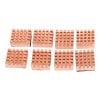FranJan
Well-Known Member
So after owning two of these lads for a bit I've come to some conclusions, (or at least have some opinions on how they operate  ). Like many things in this world there are pluses and minuses to Hans 80 panels but one of the minuses to me is the panels design as it relates to cooling, specifically junction temperature. The Hans panel is basically based on the same design that LED signs use, specifically like what the Chinese make, albeit in a much more sophisticated design as the pictures I've included show. The LEDs are mounted on a thin piece of aluminum that doubles for the heatsink and the back of the Hans "case". There is of course the one 80mm fan that sits atop it too for extra cooling. Now I've noticed some tremendous hotspots on my panels and to me that just begs the question, "How is the junction temperature being effected and what is that doing to my PAR/PPF output/readings and to my efficiency/efficacy?" To me proper junction temp is one of the, if not the key to getting the performance that you want out of your panels/LEDs. Once that junction temp increases, your efficiency drops, and less efficiency is a killer in growing MMJ and especially in monos that you've paid extra for just their efficiency alone.
). Like many things in this world there are pluses and minuses to Hans 80 panels but one of the minuses to me is the panels design as it relates to cooling, specifically junction temperature. The Hans panel is basically based on the same design that LED signs use, specifically like what the Chinese make, albeit in a much more sophisticated design as the pictures I've included show. The LEDs are mounted on a thin piece of aluminum that doubles for the heatsink and the back of the Hans "case". There is of course the one 80mm fan that sits atop it too for extra cooling. Now I've noticed some tremendous hotspots on my panels and to me that just begs the question, "How is the junction temperature being effected and what is that doing to my PAR/PPF output/readings and to my efficiency/efficacy?" To me proper junction temp is one of the, if not the key to getting the performance that you want out of your panels/LEDs. Once that junction temp increases, your efficiency drops, and less efficiency is a killer in growing MMJ and especially in monos that you've paid extra for just their efficiency alone.
 Those are also some pretty good sized heatsinks IMO and again make me think that the 80 would benefit big time from some extra cooling. So over the next few weeks I'm going to run this thread like a little notebook and try to figure out how to mod a Hans panel so we'll get a bit more performance and life out of it, but most importantly, without violating Hans' warranty
Those are also some pretty good sized heatsinks IMO and again make me think that the 80 would benefit big time from some extra cooling. So over the next few weeks I'm going to run this thread like a little notebook and try to figure out how to mod a Hans panel so we'll get a bit more performance and life out of it, but most importantly, without violating Hans' warranty  . So since I need to clean my panels, let's take a look at a Hans 80, (shout out to our friend Scotch here!), and I'm sorry about the quality of the pics
. So since I need to clean my panels, let's take a look at a Hans 80, (shout out to our friend Scotch here!), and I'm sorry about the quality of the pics  , but I got a new camera and need to practice a bit more with it:
, but I got a new camera and need to practice a bit more with it:










Now when I see Hans Noise Free model, (65 watts), he's basically just bolted on some heat sinks and charged $30 bucks more than the actively cooled original Hans panel.










Last edited:


 .
.


